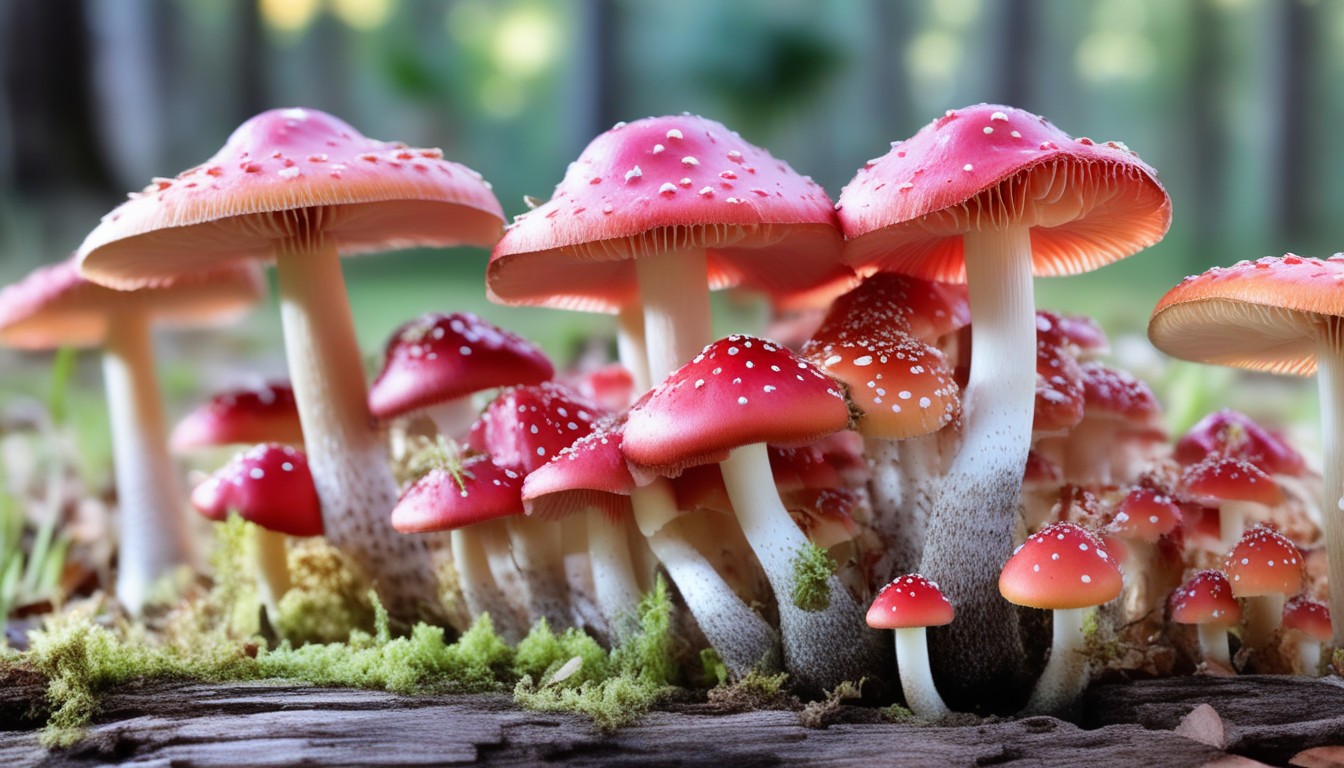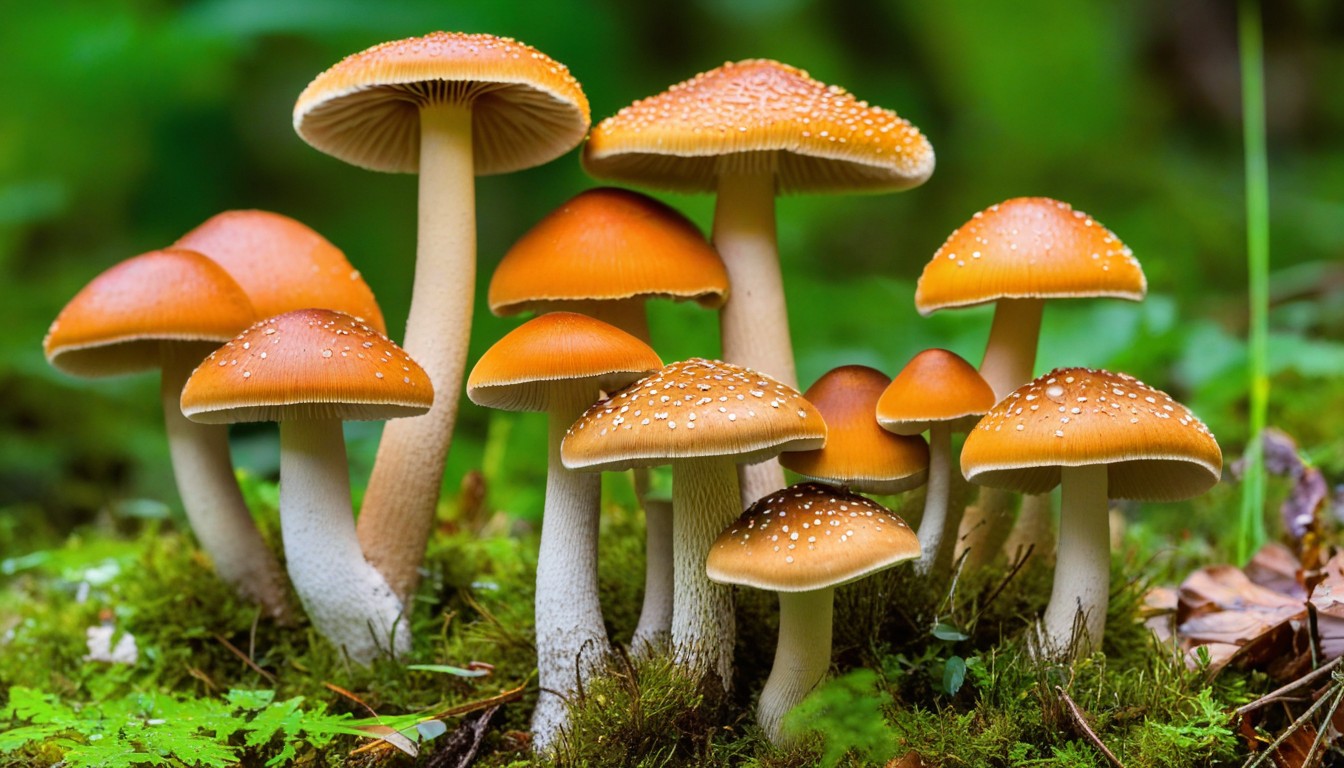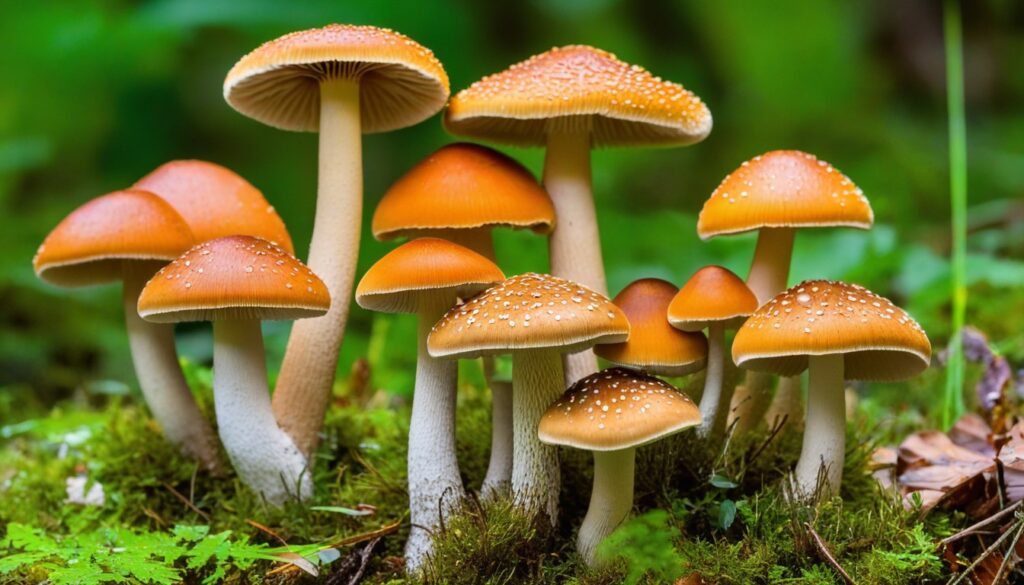If you’re an adventurous foodie or nature enthusiast, there’s nothing quite like the thrill of foraging for edible mushrooms in the wild. And if you’re in Florida, you’re in luck! The Sunshine State is home to a wide variety of delicious edible mushroom species, just waiting to be discovered.
In this guide, we’ll take you on a journey through the world of Florida’s edible mushrooms. From identifying different species to discovering the best locations for foraging, we’ve got everything you need to get started on your own mushroom hunting adventures.
Key Takeaways:
- Florida is home to many edible mushroom species
- Foraging for mushrooms in the wild can be an exciting and fulfilling activity
- Proper identification and sustainable foraging practices are crucial for a safe and enjoyable mushroom hunting experience
- Seasonal availability is an important factor to keep in mind when searching for edible mushrooms
- Florida’s edible mushrooms can be used in a variety of delicious culinary dishes
The Benefits of Mushroom Foraging in Florida
Are you looking for a new hobby that combines nature, fresh food, and adventure? Mushroom foraging in Florida might be just what you need. Not only is it a fun and exciting activity, but it also has numerous benefits for your health and well-being.
- Connecting with nature: When foraging for mushrooms, you’ll have the opportunity to explore the beautiful and diverse natural landscape of Florida. You’ll get some fresh air and exercise as you forage through forests, fields, and wetlands.
- Enjoying fresh, locally sourced food: Foraging for your own mushrooms means that you’ll have access to fresh, organic produce that you can’t find in grocery stores. Plus, you’ll learn about the different varieties of mushrooms and how to cook them in unique and flavorful ways.
- Reducing stress and anxiety: Spending time in nature has been shown to have a positive impact on mental health, reducing stress and anxiety levels. Mushroom foraging can be a calming and meditative experience, allowing you to unplug and focus on the present moment.
- Improving physical health: Foraging for mushrooms requires activity and movement, which can improve your physical health and strengthen your muscles. Additionally, many edible mushroom species have health benefits, including anti-inflammatory and immune-boosting properties.
Overall, mushroom foraging in Florida is a rewarding and fulfilling activity that provides numerous benefits. Ready to give it a try? Let’s explore the world of edible mushrooms in the Sunshine State.
Common Edible Mushroom Species in Florida
Florida is home to many delicious and nutritious edible mushroom species. Whether you’re a beginner or an experienced forager, it’s important to know which mushrooms are safe to eat. In this section, we will introduce you to some of the most common edible mushroom species in Florida and provide tips on how to identify them.
1. Chanterelles
Chanterelles are a favorite among many mushroom foragers in Florida. They have a rich, nutty flavor and a distinctive trumpet-shaped cap. Chanterelles can be found in both wet and dry environments, usually growing in clusters. They are typically orange or yellow in color and have a slightly fuzzy stem.
2. Morels
Morels are another highly sought-after edible mushroom species in Florida. They have a cone-shaped cap with a wrinkled surface and a hollow stem. Morels can be found in woodlands and near forests, usually among fallen leaves and other debris. They are typically brown or tan in color.
3. Oyster Mushrooms
Oyster mushrooms are a delicious and versatile edible mushroom species found throughout Florida. They have a delicate, fruity flavor and a distinctive oyster-shaped cap. Oyster mushrooms can be found growing on trees, logs, and stumps, usually in large clusters. They are typically grey, white, or tan in color.
4. Black Trumpet Mushrooms
Black trumpet mushrooms are a highly sought-after edible mushroom species in Florida known for their rich, smoky flavor. They have a thin, trumpet-shaped cap and a slightly curved stem. Black trumpet mushrooms can be found growing in woodlands, usually near oak trees. They are typically black or dark brown in color.
|
Mushroom Species |
Environment |
Appearance |
|---|---|---|
|
Chanterelles |
Wet and dry environments |
Orange or yellow cap with a slightly fuzzy stem |
|
Morels |
Woodlands and near forests |
Brown or tan cone-shaped cap with a hollow stem |
|
Trees, logs, and stumps |
Grey, white, or tan oyster-shaped cap | |
|
Black Trumpet Mushrooms |
Woodlands near oak trees |
Black or dark brown with a thin, trumpet-shaped cap and curved stem |
Remember, these are just a few of the common edible mushroom species found in Florida. Always double-check your identification and never eat a mushroom unless you are 100% sure it is safe and edible. In the next section, we will provide you with safe identification tips for foraging for edible mushrooms in Florida.
Safe Identification Tips for Florida Edible Mushrooms
Foraging for edible mushrooms can be a thrilling adventure. However, it can also be dangerous if you don’t know how to safely identify the mushrooms you find. Here are some essential tips to help you distinguish edible mushrooms from their poisonous lookalikes in Florida:
- Always use a field guide: A reliable field guide is an excellent resource for identifying edible mushrooms. Make sure to carry one with you when foraging.
- Look closely: Observe the physical characteristics of the mushroom, including its size, shape, color, and texture. Familiarize yourself with the key identification features of different species.
- Smell and taste: This technique is not recommended for amateurs but experts say that a mushroom’s smell and taste are crucial identifying characteristics.
- Don’t rely on folklore: Leave the folklore behind. Several dangerous mushroom species may be overlooked because they have no folklore associations and grow in places where many edible mushrooms are found.
- When in doubt, throw it out: If you’re not sure whether a mushroom is safe to eat, don’t take chances. It’s better to be safe than sorry.
By following these safe identification tips, you’ll have a better chance of avoiding poisonous mushrooms and enjoying the delicious edible mushrooms that Florida has to offer.
Seasonal Availability of Edible Mushrooms in Florida
Florida’s unique climate and ecology provide for a diverse range of edible mushroom species that can be foraged throughout the year. Understanding the seasonal availability of these delicious fungi is crucial for a successful foraging experience.
|
Mushroom Species |
Seasonal Availability |
|---|---|
|
Chanterelles |
Spring to early summer |
|
Morels |
Spring |
|
Lions Mane |
Fall to late winter |
|
Oysters |
Fall to early winter |
|
Boletes |
Summer to early winter |
It’s worth noting that seasonal availability can vary based on factors such as weather conditions, elevation, and microclimates. Always research and observe your foraging area to determine the best time to search for specific mushroom species.
When foraging for edible mushrooms in Florida, be sure to exercise caution and only consume mushrooms that you have reliably identified as safe. Refer to our Safe Identification Tips for Florida Edible Mushrooms section for essential guidance on identifying edible mushrooms.
Where to Find Edible Mushrooms in Florida

Florida boasts a diverse range of environments that are home to a variety of edible mushrooms. Below, we’ll explore some of the best locations and habitats where you can find these delicious fungi:
Forests
Florida’s forests are a prime spot for mushroom foraging. Look for oak, pine, and cypress trees, which are known to harbor a wide variety of mushrooms including chanterelles, boletes, and morels.
Wetlands
Wetlands are another excellent habitat to find mushrooms. Look for areas with standing water or near cypress trees for the best chance of finding edible varieties like oyster mushrooms and black trumpets.
Urban Areas
Believe it or not, edible mushrooms can even be found in urban areas like parks and gardens. Keep an eye out for wood chips, mulch, or decomposing plant matter, which can harbor species like shiitakes and honey mushrooms.
“Remember to always ask for permission before foraging in private or protected areas.”
Wherever you choose to forage, always remember to practice safe identification techniques and sustainable foraging practices to ensure the longevity of the mushroom populations and the health of the environment.
Best Practices for Sustainable Foraging in Florida

If you’re planning on foraging for edible mushrooms in Florida, it’s important to keep sustainability in mind. Here are some best practices to help ensure that you minimize your impact on the environment and maintain the longevity of mushroom populations:
1. Respect the Environment
When foraging for mushrooms, always remember that you are a visitor in the environment and take steps to minimize your impact. Stick to established trails and avoid trampling any surrounding vegetation. Leave no trace of your visit and pack out any trash or other non-biodegradable items.
2. Don’t Overharvest
It’s important to only take what you need when foraging for mushrooms, as overharvesting can significantly impact local populations. Only take mature specimens and leave behind any that are too small or underdeveloped. If you’re unsure whether a certain type of mushroom is in danger of being overharvested, err on the side of caution and look for alternatives.
3. Know Your Mushrooms
Before heading out to forage for mushrooms, make sure you are confident in your identification skills. Mistaking a poisonous mushroom for an edible one can have serious consequences, both for you and for the environment. Use reputable field guides and other resources to help you correctly identify different species, and never harvest any mushrooms that you are unsure about.
4. Avoid Protected Areas
Many protected areas, such as state parks and natural reserves, have restrictions on foraging for mushrooms and other plants. Make sure you are familiar with local regulations before heading out to forage and respect any posted signs or boundaries.
5. Spread the Word
Finally, one of the best ways to promote sustainable foraging practices is to share your knowledge with others. Encourage fellow foragers to follow best practices and help raise awareness about the importance of sustainability in mushroom foraging and other outdoor activities.
Culinary Uses of Florida Edible Mushrooms
Florida’s edible mushrooms offer a world of culinary possibilities. Once you’ve foraged your finds and safely identified them, it’s time to bring them to the kitchen and explore their flavors.
One of the best ways to enjoy Florida edible mushrooms is in soups and stews. Try adding sliced mushrooms to a hearty vegetable soup for a rich, earthy flavor. Or, add them to meat-based stews for an extra punch of umami.
Mushrooms also make a great addition to sautés and stir-fries. Sauté sliced mushrooms in a pan with onion and garlic, and serve over rice or pasta for a quick and flavorful meal. You can also add mushrooms to omelets, frittatas, and quiches for a tasty breakfast or brunch option.
If you’re looking for a lighter option, try adding chopped mushrooms to your favorite salads. They add a nice texture and rich flavor that complements leafy greens and other fresh ingredients.
Mushroom and Spinach Quiche Recipe

- Preheat oven to 375°F.
- In a skillet, sauté 1 cup of sliced Florida edible mushrooms with minced garlic and diced onions until soft.
- Add 2 cups of fresh spinach and cook until wilted.
- In a mixing bowl, whisk together 5 eggs and 1/2 cup of milk. Season with salt, pepper, and a pinch of nutmeg.
- Spread the mushroom and spinach mixture evenly in a 9-inch pie dish. Pour the egg mixture over the vegetables. Top with shredded cheese.
- Bake for 35-40 minutes, or until the egg mixture is set and the cheese is melted and bubbly.
- Serve hot and enjoy!
As with any mushroom dish, be sure to cook your Florida edible mushrooms thoroughly to bring out their full flavor and reduce any potential risk of foodborne illness. With these culinary tips and recipes, you’re sure to have a delicious, mushroom-filled meal in no time!
Conclusion
We hope that this guide has provided you with all the information you need to safely identify and forage for delicious edible mushrooms in Florida. Remember to always be cautious when foraging and use proper identification techniques to avoid any potentially harmful mushrooms.
By practicing sustainable foraging methods, we can help preserve mushroom populations and continue to enjoy this nutritious and flavorful food source for generations to come.
So put on your hiking boots, grab a basket, and head out into the Florida wilderness to hunt for some tasty mushrooms. With the knowledge and tips provided in this guide, you are sure to have a successful and satisfying foraging experience. Happy hunting!
FAQ
How do I safely identify edible mushrooms in Florida?
To safely identify edible mushrooms in Florida, it is important to follow a few key tips. Firstly, make sure to thoroughly research and educate yourself on the different species of edible mushrooms in the region. Look for field guides or join local mushroom clubs to gain knowledge and expertise. Secondly, pay attention to the physical characteristics of the mushrooms, such as their shape, color, and texture. Take note of any distinctive features that can help with identification. Lastly, when in doubt, always consult with an experienced mycologist or expert to confirm the identification before consuming any wild mushrooms.
Are there any poisonous mushrooms in Florida that I need to be aware of?
Yes, Florida is home to several poisonous mushroom species that can be harmful if ingested. Some common poisonous mushrooms found in the region include the Amanita species, specifically the Amanita phalloides (Death cap) and Amanita bisporigera (Destroying angel). It is crucial to be able to differentiate between edible and poisonous mushrooms to prevent any potential health risks. Remember, unless you are absolutely certain of the edibility of a mushroom, it is best to err on the side of caution and avoid consumption.
Can I forage for mushrooms in Florida’s national parks?
It is important to note that foraging for mushrooms in national parks is generally prohibited. National parks are protected areas that aim to preserve the natural habitat and wildlife, including fungi species. Therefore, it is recommended to respect the regulations and not to forage for mushrooms within national parks. However, there are plenty of other public lands, such as state parks and forests, where mushroom foraging may be allowed. Always check with the specific park’s regulations before foraging.
Can I sell the mushrooms I forage in Florida?
In Florida, regulations regarding the sale of foraged mushrooms can vary. It is advisable to familiarize yourself with the state’s laws and regulations regarding the sale of wild mushrooms. If you are interested in selling mushrooms, it is best to consult with local authorities or agricultural extension offices to ensure compliance with any licensing or permitting requirements. Additionally, remember to only sell mushrooms that have been accurately identified and are safe for consumption.
Are there any specific seasons or times of the year when edible mushrooms are more abundant in Florida?
Yes, there are certain seasons when edible mushrooms are more abundant in Florida. Fall and spring are generally the best times to find a variety of edible mushroom species. The warm and humid climate of Florida during these seasons creates optimal conditions for mushroom growth. However, it is important to note that mushroom availability can also be influenced by rainfall patterns and other environmental factors. It is recommended to research the specific mushroom species you are interested in foraging to determine the best time of year for hunting.
Can I consume raw mushrooms that I find in the wild?
While some edible mushrooms can be consumed raw, it is generally recommended to cook wild mushrooms before consuming them. Cooking mushrooms helps to break down their cell walls and makes them more easily digestible. Furthermore, cooking destroys any potentially harmful bacteria or parasites that may be present. To ensure safety and enhance the flavor of your mushrooms, it is best to cook them thoroughly through sautéing, roasting, or incorporating them into various cooked dishes.

